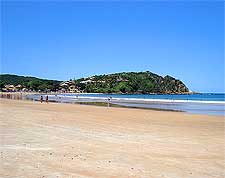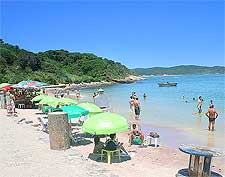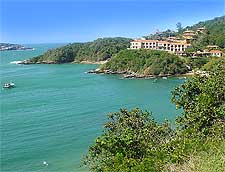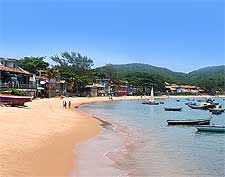Buzios History Facts and Timeline
(Buzios, Rio de Janeiro, Brazil)

Untouched by the outside world for centuries, this coastal outcrop was the home of the Tupinamba Indians at the start of the 16th century, when the first Europeans arrived.
French pirates scouting up and down the coast east of
Rio de Janeiro discovered that Buzios was abundant in Brazilwood trees, a dense hardwood they started to harvest with the help of Tamoio Indians. Back in Europe, this exotic timber was used to produce high quality musical instruments and red dye for clothing. This is how Buzios history came about.
A Diving Legacy
By the end of the 16th century, the French presence in Buzios had become a nuisance for the Portuguese, who had already taken over large parts of Brazil. In 1575, D'Antonio Salema, the governor of Rio de Janeiro, began a campaign to rid the area of the French pirates and their business partners, the Tamoio. This was finally achieved in 1615.
By this time the Portuguese had named the town Buzios, which translates as 'diver', a reference to the thriving trade in sea shells shorn from the sea bed. During this period, Buzios quickly developed as a fishing village and centre for whale hunting.

A Fishing Village
As the gold rush hit other parts of Brazil during the 18th century, the main industries of whale hunting and slave trading had reached their heyday in Buzios.
In the area around Guanabara Bay, the once abundant population of whales started to decline dramatically and the town became busy with fishermen, catching and salting fish to sell in the markets of Rio.

The End of Slavery
The town was a hive of activity in the early 19th century, being a focal point for slaves gathered from across the country, who were then shipped to the colonies and back to Europe. It was not until 1850 that the trade in humans was finally abolished, prompting the government to station navy vessels off Buzios to enforce the ban. History had caught up with Buzios and it went into somewhat of a decline. It was during this period that freed slaves established a fishing community at Rasa Beach.

Brigitte Bardot
Whereas fleets of Gallic pirates were responsible for the timber trade in the 16th century, in the 1960s it took just one French woman to launch the tourist industry in Buzios. When Brigitte Bardot arrived in 1964 with her Brazilian boyfriend at the time, Bob Zagury, Buzios was little more than a fishing village of 300 people.
Escaping the cameras in Rio, Bardot stayed here longer than planned. By the time she left, the town would never be the same again. It quickly developed into a high-end resort - a place for the rich and famous to escape the hustle and bustle of Rio. The significance of Bardot in the history of Buzios is commemorated by a bronze statue in the town.
 Untouched by the outside world for centuries, this coastal outcrop was the home of the Tupinamba Indians at the start of the 16th century, when the first Europeans arrived.
Untouched by the outside world for centuries, this coastal outcrop was the home of the Tupinamba Indians at the start of the 16th century, when the first Europeans arrived.

